My intentions for researching & writing about asthma & it’s multiple triggers with environmental fire smoke are numerous. As a health practitioner that saw the intense strain on many Seattlites coping with the most basic of human needs, being able to breathe, it registered in my mind as huge red flag. I saw dozens of people wearing scarves over their faces in the downtown area every day, exponentially so many more numbers of families running to their pulmonary specialists or hospitals to get back up support with bronchial dilator medications. Chronic asthma & acute asthma flare ups spiked to record highs spurned on by the lingering forest fire smoke. Late August 2017 & 2018, West coasters in BC, Washington, Oregon & California states were exposed to over 378 forest fires & their residual smoke lingering for weeks along the Pacific coastline and blanketing many urban centers.
Global warming is altering where areas of the country receive precipitation & others only meagerly with long standing droughts, excessive heat temperatures all indirectly effecting the drying of our forest soils and trees. These invisible ecological influences are influencing our vast resources of parched wild timberland with millions of trees being burnt up, catalyzed simply by a spark via human error or thunder striking. Parched conifer forests can set off uncontrollable forces with ravaged forest fires blackening our skies for hundreds of miles carrying tiny particles of ash, soot & chemicals. We are all exposed to this smoke in our environment and it takes time for the forces of nature to clear that out.
As an allergy trained acupuncturist, I was overwhelmed with hundreds of people, both adults & children that were exposed & devastated by getting some quality of air to just breathe adequately. The lingering soot and smoke in the air low lying in downtown Seattle triggered thousands of individuals having asthma attacks or experiencing inflamed lung conditions & utilizing various medications & bronchial dilators much more frequently. The few pulmonary medical specialists & ER rooms were swamped with people seeking medical aide.
I am preparing myself for this late summer wave of 2019 of forest fires & how it will exponentially affect so many more people’s respiratory systems, both children & adults coping with low grade inflammatory lung conditions. It is my desire to empower people through these health challenges that are at the mercy of intense secondary smoke and air pollution. There are ways to cope with lingering smoke better, when we are prepared ahead of time though home & work air filters, air masks, bronchial medications, nutritional supplements and herbs that can aid the respiratory systems of those that are more vulnerable & incapacitated.
Not everyone has the same sensitivity to wildfire smoke. You will be more at risk if you have low grade chronic respiratory challenges, such as asthma, emphysema, COPD & long standing smokers or their loved ones exposed to their secondary smoke. Children and teenagers are more susceptible to aggravating sinuses, lungs & bronchials, because they are still developmentally growing. Keep in mind that younger children breathe more air & their pollutants per pound of their body weight than adults & are more likely to be active outdoors, taking in aggravating environmental chemicals & pollens.





